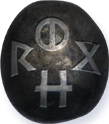13th Age
13th Sage: Icon Riffs for the Crusader and High Druid
 The Icon Riffs series offers inspiration for adventure design and improvisation at the table. The ideas presented aren’t numbered, because numbered lists imply a certain consistency between results. These lists are evocative rather than consistent.
The Icon Riffs series offers inspiration for adventure design and improvisation at the table. The ideas presented aren’t numbered, because numbered lists imply a certain consistency between results. These lists are evocative rather than consistent.
They’re also not thorough. This isn’t an attempt to list all the things that could be associated with the icons. There are huge numbers of worthwhile connections already scattered through our books and through players’ and GM’s websites. Instead of cataloging existing ideas, these notes are a brainstorm touching on ideas we haven’t already presented in detail. Some ideas may feed into future products.
The Crusader
 Temples where demons are destroyed permanently in rituals that siphon their power away to the Crusader’s gods; ‘airships’ powered by winds that blow only from hellhole to hellhole, so that the Crusader’s armies can float between hellholes when the ‘winds’ are right—or wrong, depending on what’s actually going on here; bridges built where bridges are most required that can be freely used by the populace, so long as everyone crossing provides their true name (lies are often detected) and their intentions for this travel.
Temples where demons are destroyed permanently in rituals that siphon their power away to the Crusader’s gods; ‘airships’ powered by winds that blow only from hellhole to hellhole, so that the Crusader’s armies can float between hellholes when the ‘winds’ are right—or wrong, depending on what’s actually going on here; bridges built where bridges are most required that can be freely used by the populace, so long as everyone crossing provides their true name (lies are often detected) and their intentions for this travel.
Occasional ‘high cullings,’ in which the temples and worshippers of the weakest of the dark gods—at that time—are destroyed and sacrificed or driven away so that the strongest gods get stronger—and so that the strongest gods are careful to make sure they never become weak. Public-minded pension programs that provide additional assistance to widows and families of Imperial veterans, so long as those families send one daughter or son to join the Crusader’s armies; literacy initiatives that create generations of readers with an extremely dark vocabulary.
Knights or warriors in full plate who ride forth to accomplish their mission and then seem to freeze, and when someone finally dares to investigate the motionless armor, it’s empty—at least for now; likewise, walls and fortifications that appear to be patrolled by dozens or hundreds of warriors, but it’s difficult to say which armor is occupied and which is not, especially since the unoccupied armor sometimes moves.
Renamed holidays and festivals, so that every worthwhile celebration is named after a past or present general or mighty crusader, with new ‘traditions’ playing off the original traditions in ways that sometimes get adopted by people who otherwise oppose everything the Crusader stands for; unpredictable amnesties for crimes that do not support the Diabolist or (generally) damage the Emperor.
 The High Druid
The High Druid
Ancient magical stones that have been allowed to weather; holy stones that have not been carved upon but instead gradually grown into somehow organic shapes; menhirs sprouting living trees; plinths covered in flowers, in patterns that reveal problems in the forest.
Great monsters that break through the Sea Wall, but somehow subside and find a hole to burrow into deep within the Wild Wood; great subterranean creatures that more or less follow the Koru behemoths; great creatures never seen on the surface, that have occasionally been known to swallow an entire living dungeon; beasts that used to live in the Midland Sea but now sleep somewhere upriver, waiting for the day when the wizardry that tames the Midland Sea falls shattered; rangers or druids or monster killers or manipulative wizards who take it upon themselves to uncover and learn about the giant creatures that live just beyond the Empire.
Forests with canopies shorter than humans, cultivated or guarded by gnomes, pixies, or halflings; traveling human raft communities that convert to lake towns on pole houses when they reach their magically prepared seasonal moorings; human tribes who reincarnate into the local otter population and then back again into the human clans, so that the two groups have distantly understood kinships and fur hunting will get you killed either way; animals that talk to people but only at specific phases of the moon, which makes it the beasts’ equivalent of lycanthropy, a blessing to some and horrible disease to others.
13th Age combines the best parts of traditional d20-rolling fantasy gaming with new story-focused rules, designed so you can run the kind of game you most want to play with your group. Created by Rob Heinsoo and Jonathan Tweet, 13th Age gives you all the tools you need to make unique characters who are immediately embedded in the setting in important ways; quickly prepare adventures based on the PCs’ backgrounds and goals; create your own monsters; fight exciting battles; and focus on what’s always been cool and fun about fantasy adventure gaming. Purchase 13th Age in print and PDF at the Pelgrane Shop.


